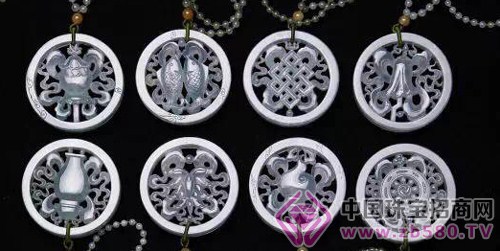The jade was the earliest artifact of the emperor's sacrifice to the heavens and the earth. It is a kind of communication that connects the human world with the world. It can make people live forever and become a Buddha. Only the emperors and nobles have the right to own a jade. The possession or wearing of jade articles by civilians is a crime of decapitation. Generally speaking, from the Tang Dynasty, the use of jade articles was no longer so strict. Jade began to have practical functions, became a work of art for the scholars, and entered the people's homes. That is to say, from this time on, jade articles pay attention to "the picture must be intentional, the meaning must be auspicious", and now many of the subject matter of the subject has been formed at that time. The patterns appearing in the jade are the sun, the moon, the mountains and the rivers, the clouds, the rain and the fog, the pavilions and pavilions, the fisherman's nursery rhymes, the immortals and the beasts, the gods and the beans, the exquisite is the auspicious meaning of it, and hope that the world External strength brings happiness and blessness to the wearer. We often see that jadeite combines the cultural elements of Buddhism, combining the spirituality of natural jade and jade with the divine compassion of Buddhism, meaning more auspicious. It is mainly composed of eight kinds of patterns, called eight auspicious, also known as Buddhist eight treasures. It consists of eight mascots, such as the snail, the Falun, the umbrella, the white cover, the lotus, the bottle, the goldfish, and the disk. It is said that they respectively represent the Buddha. Head, eyes, throat, tongue, teeth, heart, body and feet. Let me introduce you to these eight mascots: 1. Bao Umbrella: When ancient India and the royal family members traveled, they used umbrellas to cover the sun, and later evolved into ceremonial instruments, meaning the supreme authority. Buddhism symbolizes the obstacles and protects the Dharma. Tibetan Buddhism also believes that the umbrella symbolizes the authority of the Buddha. It means covering everything, opening and closing freely, is a symbol of protecting all beings. 2, goldfish: fish in the water, smooth and unimpeded. Buddhism uses its metaphor to describe practitioners who transcend the world and are free and open-minded. In Tibetan Buddhism, a pair of goldfish is often used to symbolize the liberation, and it symbolizes recovery, eternal life, and regeneration. It means lively and healthy, full of vitality, and is a symbol of shunning evil. 3. Aquarius: The bottle in the Tibetan Buddhist monastery contains water (nectar) and gemstones, and the bottle is filled with peacock or Ruyi tree. It symbolizes auspiciousness, purity and wealth, and symbolizes that there is no leakage, perfection, and immortality. It is a symbol of success. 4. Lotus: The lotus leaves the sludge without dyeing, until it is pure to pure. Tibetan Buddhism believes that the lotus symbolizes the ultimate goal, that is, to cultivate a positive result. Representing sacred purity and spotlessness is a symbol of refusal of pollution. 5, the law snail: the Buddhist scriptures, Sakyamuni said when the sound is shocking, such as the sound of conch. Therefore, the Conch is often blown at the time of the Fa Conference. In Tibet, the right-handed white conch is the most respected and is regarded as a symbol of the world of three thousand. It means that the Buddha is auspicious and spread all over the world. It is a symbol of good luck. 6, auspicious knot: also known as the length of the disk, the original meaning symbolizes love and dedication. The explanation of Buddhism also symbolizes that if you follow the Buddha, you will be able to salvage the wisdom pearl and the enlightenment treasure from the ocean of existence. Representing the return to everything, never ending, is a symbol of longevity. 7. Victory Building: The white cover is a kind of military flag in ancient India. Buddhism uses the meaning of the building to worry about the roots and liberation. Tibetan Buddhism uses its metaphor to describe the ten kinds of troubles, namely, the ring, the set, the wisdom, the liberation, the great sorrow, the emptyness, the incompetence, the convenience, the selflessness, the understanding, the prejudice, and the blessing of the Buddha. Pure and clean. It means to cover the world and purify the universe. It is a symbol of relief from poverty. 8. Falun: In ancient India, the wheel was a powerful weapon, and it was borrowed for Buddhism. It symbolizes that the Dharma rotates like a wheel and never stops. It means the round of Dharma, which is a symbol of life. Bubble Fabric,Yarn Dyed Fabric,Cationic Fabric,Solid Dyed Fabric CHANGXING YONGXIN IMPORT AND EXPORT CO.,LTD , https://www.cxyxfabric.com